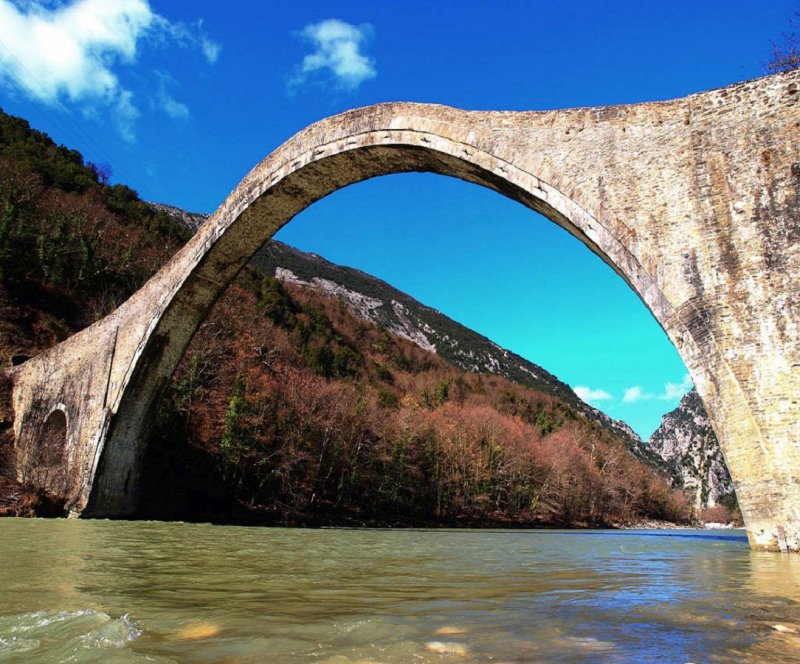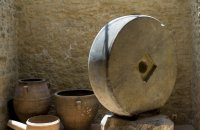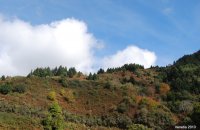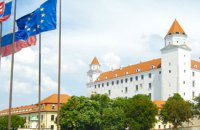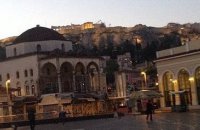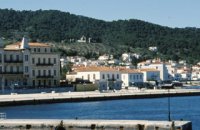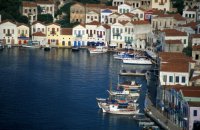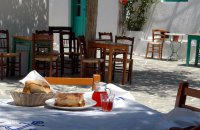Each of these five mountaintops exceed an altitude of 2,000 meters, thus comprising the most formidable part of the Pindos Range. Then, three rivers- the Arahthos on the west, the Aheloos on the east and the Kalarritikos on the north- lend extended natural boarders to the stunning region.

On the road …
Access to the Tsoumerka mountains is possible via a variety of routes, two of which require four-wheel drive vehicles or dirt-road motorbikes. Via any of these routes, you can arrive at the beautiful villages of Syrrako, Kalarrites, Christi and Pramanda.
With a conventional motor car or street motorbike, the journey may start from the town of Ioannina, following the southeastern route through the tiny villages of Anatoli, Katstika, Kastelia, Harokopi, Petrovouni, Potistiko, Paleohori and Prosilio, a route that involves the treacherous climb from Harokopi to Petrovouni.
Beginning from the town of Arta, the second recommended route involves driving north and passing through the villages of Grammenitsa, Elato, Podavgi, Soumesi, Platanousa, and Agnanda. Return via either the reverse route, or through the town of Ioannina.
With a four-wheel drive vehicle or dirt-road motorbike, one can approach Kalarrites from Thessaly, passing through the villages of Elati, Pertouli, Neraidohori, and Desi, respectively. Then, travel alongside the river Aheloos (Aspropotamos) towards the villages of Milia, Katafito and Anthousa. Once you reach Anthousa, turn left off the main road and begin the dirt road through the alpine passage of Baros that will bring you to the village Kalarrites after 21 km.
If you’ve decided to travel along the Ioannina–Trikala national road, travel south from the village of Mega Peristeri (18km west of Metsovo), passing through Kastri and Kariofito and following the 25km dirt road that leads to Syrrako through the mountainous passage of Ag. Apostolos. But take note: these dirt roads may not be accessible during the winter months.
If you choose to travel from Ioannina, you will reach the village of Prosilio after 45 km of hard driving. Once you reach the village exit, follow the road on your left at the fork crossing towards Syrrako- only 8 km away. The asphalted drive joining the two villages is truly spectacular. The steep climbing road right at the edge of the cliff offers magnificent views of the surrounding mountaintops, with the waters of Kalarritikos roaring towards their Arahthos-river meeting point at the depths of the gorge.

Tame the mountains to reach Syrrako!
Surrounded by amazing natural scenery, the proud village of Syrrako stands at 1150 m above sea level. Though founded in the 14th century by Vlach Greeks, mainly farmers, this historical settlement reached the peak of its cultural and economic prosperity during the 16th and 17th centuries.
Leave your car at the slope of the mountain and then begin your climb along the stone-paved path of Kalderimi. This path will take you directly into the “stone” heart of Syrrako, one of the best preserved cultural heritage settlements of Epiros. As you walk around the village, you cannot help but notice the ubiquity of stone within the unique local architecture. The village is comprised of quaint stone houses, most of which have recently been renovated and restored, but still retain the impression of bygone days. Look for the church of Saint Nicolas with the spectacular wooden chancel and “Goura” spring.
Built on the two opposite slopes of Mt Peristeri, or “dove” in Greek, the villages of Syrrako and Kalarrites are joined by a stone cobbled path. The path passes perpendicularly through the gorge of Hrousia, which, until 1881, marked the northern-most boarder of the Greek State. Walking this path will be well-worth the effort. Though it will take more than two hours, it offers amazing views of natural beauty.
To reach Kalarrites from Syrrako by car instead, return to the village Prosilio, and travel the 4 km from there.

Monastery of Kipinis
On the road to Kalarrites from Syrrako and Prosillio, you will find the amazing Monastery of Kipinis, built in 1349 into the niche of vertical rock in the gorge of the river Kalarritikos, 40 m above the road, like an eagle’s nest. A narrow foot path leads to a wooden door of the now abandoned Monastery of Kipinis, dedicated to the Dormition of Virgin Mary. The view is spectacular.
To enter the abandoned monastery, you will have to ask for the keys at the “kafeneio,” coffee house in the village of Kipinis, on your way to the monastery. The site is no longer in use due to the plundering and damage caused by thieves within the last 25 years.
Your tour of Kalarrites
After touring the monastery, continue towards Kalarrites through the small tunnel and over the army-type bridge. As you climb the steep winding road up the mountain slope, you will find that it is not so much the climb that takes your breathe away, but the incredible natural beauty surrounding you.
Soon, you will arrive at Kalarrites. Whether to catch your breath or park your car, you will inevitably pause. Then, the network of cobbled paths will guide you into the stone world of the village, a world 1120 m above sea level. Architecturally, the village is composed of stone houses and high walls, most of which conceal small vegetable or flower gardens here and there.
While in Kalarrites, be sure to explore St Nicholas Church, arguably the most beautiful church in the Tsoumerka Mountains.
Your tour will bring you to the small square on the stone boarders of the village, a truly beautiful sample of local stone architecture. Here, in the blessed shade of the ageless plantain tree, beats the heart of the village. The traditional coffee and grocery shop of Napoleon Zaglis constitutes the lively meeting point for both locals and visitors. Lunch will usually include boiled goat, village pie filled with mountain wild greens and tasty, locally produced cheese. The meal will most likely include a strong tsipouro, the alcoholic beverage produced locally from the must residue of wine grapes, sometimes including other fruit such as figs and berries.

Your tour of the remaining villages
Taking the main road downhill, you meet the crossroad of Prosilio. Turn left and drive 3 km to the village of Christi, which is considered to be the oldest settlement within the Mountains of Tsoumerka. Inhabited from the early 12th century, the town is both scenic and redolent of history. Then, after more 7 km down the asphalt road, you will arrive at the picturesque village Matsouki.
The 8 km uphill route connecting Christi with Pramanta is probably the most beautiful stretch of road within the entire mountain range. Pramata, today inhabited by a mere 2,000 people, was once famous for its exceptional stone craftsmen. The stone houses and mansions on the outskirts of the village, and the church of Agia Paraskevi, as well as the stone square and the fountain of “Arapi,” are unique samples of this marvelous stone craftsmanship.
Visit also the cave of “Anemotripa” near Pramanta that was discovered in 1960 and by general consensus is one of the best in Greece.

Did you know?
The “House of Bulgari” was founded by the legendary Sotiris Bulgaris, an individual who was born and raised in Syrrako, before opening his first jewelry shop in Rome in 1884. Sotiris Bulgaris is the grandfather of today’s owners.

Where to stay
Syrrako
Syrrako Hotel
Tel.: (0030) 26510 53410
e-mail: [email protected]. 26510
Guesthouse Galanis
Tel. 26510-53569, 53444
Guesthouse Casa Calda
Tel. 26510-53540
Kalarrites
Guesthouse Patounis
Tel. 26510-79917, 26590-62235
Guesthouse N. Zaglis
Tel. 26590-61518, 48843
Rodavgi
Nisista Guesthouse
Phone - 2683071484
Email - [email protected]
Tel. 26830 - 71131
Pramanda
Guesthouse Tzoumerka
Tel. 26590-61336
Horizons Hotel
Pramanta-Ioannina 44001 Greece
Tel:+30 26590 61002
Fax:+30 26590 61003
info(at)orizontestzoumerkon.gr
Agnanta
Guesthouse - To arhondiko ton Tzoumerkon
Arta Agnanta
Tel: 6974358393
e-mail: [email protected]
Tel.26850-31777
Useful Information
Health Center Pramanda
Tel. 26590-61206
Police Station Pramanda
Tel. 26590-61205.
Municipality of Kalarrites Tel. 26590-61520
Municipality of Syrrako Tel. 26510-53290
Municipality of Pramanda Tel. 26590-61231
Where to eat
All the villages have delightful little tavernas with local specialities and food products.
While in Syrrako, be sure to enjoy a meal first at the guesthouse “Glani,” and then at the meat tavern “Stavraetos.”
In Kalarrites, definitely try the restaurant at Napoleon Zaglis’ guesthouse.
In Kipina, visit the tavern “Kipinia.”
There are several delicious eateries taverns around the central square of Pramanda village.
Be sure to taste the goat stew, goat casserole, local “krasomezes,” and vegetable pies.
Similarly, the locally produced dairy products are well-worth the calories.













































